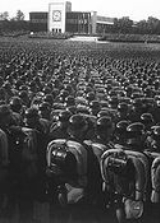jameskcal
The national park service history at Manzanar lists the term "interment" as a term that deals with "enemy aliens" or Japanese nationals held in internment camps by the Justice Department from the FBI's "ABC" list before the wwII started. The other people of Japanese ancestry were "Evacuated" into War Relocation Centers or "Concentration Camps" (President's own words)run by the civilian War Relocation Authority as a military necessity to protect the West Coast from the Japanese military invasion, which was never planned, so it never happened.
The text said we were divided into three groups, Issei,. Nisei and Kibei. The first two terms deal with the first and second genration Japanese that came to America and those American citizens born in america. They are merely generation numbers, first and second generation references.
some writers have used the word "internment" to include all people of Japanese ancestry that were moved from their homes in Alaska, Hawaii, Oregon and Washington West of the Cascade Mountains, eventually all of California and Arizona south of Highway 66.
The government handled two groups of people of Japanese ancestry. Those on the "ABC" were picked up with German nationals and Italian nationals as enemy aliens under the enemy alien act. by the end of February, about 2,000 Japanese, about 1,000 Germans and about 400 Italians were housed in Justice "Internment" camps, like Ft. Missoula Montana, Ft. Lincoln North Dakota and Santa Fe New Mexico.
Later President Roosevelt passed Excutive Order 9066 which gave General Dewitt power to protect the West Coast military bases and defense plants by evacuating people of Japanese ancestry as mentioned above into Assembly centers, while the Relocation Centers were being constructed at ten locations (two of which were in the exclusion zone), mainly in the inter-mountain states. TRhis turned out to be a blessing for the subgar beet farmers and sugar beet companies as the government had lifted the quota on sugar beet acreage to double the acres of sugar beets. The demand for sugar was high, but alcohol demand was even higher as it was used to meet the shortage of natural rubber (Japan took over French-Indo China that grew 9/10th of the US rubber supply)by producing synthetic rubber. A soldier had 32 pounds of rubber. A tank 2,000 pounds. Trucks, jeeps and pland had rubber tires. Alcohol was also used to produce smokeless explosives.
Guess who was recuited to work the sugar beet fields from spring thinning to the fall harvest? People that were cleared by the FBI were released from the Relocation centers!
I hope this clarifies the informtion posted about the War Relocation Authority. All of the above information is available from government documents and the American Chemcial Society.
The text said we were divided into three groups, Issei,. Nisei and Kibei. The first two terms deal with the first and second genration Japanese that came to America and those American citizens born in america. They are merely generation numbers, first and second generation references.
some writers have used the word "internment" to include all people of Japanese ancestry that were moved from their homes in Alaska, Hawaii, Oregon and Washington West of the Cascade Mountains, eventually all of California and Arizona south of Highway 66.
The government handled two groups of people of Japanese ancestry. Those on the "ABC" were picked up with German nationals and Italian nationals as enemy aliens under the enemy alien act. by the end of February, about 2,000 Japanese, about 1,000 Germans and about 400 Italians were housed in Justice "Internment" camps, like Ft. Missoula Montana, Ft. Lincoln North Dakota and Santa Fe New Mexico.
Later President Roosevelt passed Excutive Order 9066 which gave General Dewitt power to protect the West Coast military bases and defense plants by evacuating people of Japanese ancestry as mentioned above into Assembly centers, while the Relocation Centers were being constructed at ten locations (two of which were in the exclusion zone), mainly in the inter-mountain states. TRhis turned out to be a blessing for the subgar beet farmers and sugar beet companies as the government had lifted the quota on sugar beet acreage to double the acres of sugar beets. The demand for sugar was high, but alcohol demand was even higher as it was used to meet the shortage of natural rubber (Japan took over French-Indo China that grew 9/10th of the US rubber supply)by producing synthetic rubber. A soldier had 32 pounds of rubber. A tank 2,000 pounds. Trucks, jeeps and pland had rubber tires. Alcohol was also used to produce smokeless explosives.
Guess who was recuited to work the sugar beet fields from spring thinning to the fall harvest? People that were cleared by the FBI were released from the Relocation centers!
I hope this clarifies the informtion posted about the War Relocation Authority. All of the above information is available from government documents and the American Chemcial Society.


